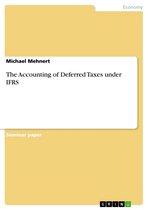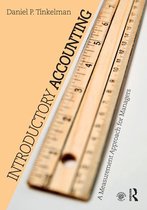Accounting for Derivatives (US-GAAP) Ebook Tooltip Ebooks kunnen worden gelezen op uw computer en op daarvoor geschikte e-readers.
Afbeeldingen
Sla de afbeeldingen over
Artikel vergelijken
Auteur:
Jörg Decker
- Engels
- E-book
- 9783638206440
- 23 juli 2003
- 31 pagina's
- Adobe ePub
Samenvatting
Some years before the financial scandal of Enron, which was mainly caused by the misuse
of derivatives, the Financial Accounting Standard Board (FASB) began deliberating
on issues related to derivatives and hedging transactions.1 The cause of thinking about
changes in accounting for derivatives was a problematic situation in 1986 (comparable
to current situation in Germany). For example, the applicatory use was very complicated
and transactions with derivatives were not transparent enough. There were only clear
standards for a few product groups and transactions with derivatives were not reported
on the balance sheet.2
In consequence, first in 1986, a work program called Project on Financial Instruments
was founded.3 In 1992 the members of the FASB received the responsibility in working
on derivatives and continued improving the existing statement for about six years in
more than 100 meetings. In June 1998 (06/16/1998) the Statement for Financial Accounting
Standard (SFAS) No. 133 'Accounting for Derivative Instruments and Hedging
Instruments' passed as an outcome of these efforts and is valid for every entity.4
Some public voices say, it is one of the most complex and controversial standards ever
issued by the FASB.5
Statement No. 133 replaced FASB Statement No. 80 (Accounting for Future Contracts),
No. 105 (Disclosure of Information about Financial Instruments with Off-Balance-Sheet
Risk and Financial Instruments with Concentrations of Credit Risk) and No. 119 (Disclosures
about Derivative Financial Instruments and Fair Value of Financial Instruments).
6 Also FASB Statement No. 52 (Foreign Currency Translation) and No. 107
(Disclosures about Fair Value of Financial Instruments) were amended, by including the
'disclosure provisions about concentration of credit risk' form Statement No. 105 in
Statement No.107.
Despite the fact that the new Statement was issued in June 1998 it only was effective on
financial statements for fiscal years beginning after June 15, 2000. [...]
1 Cp. Ernst & Young LLP (2002), p. 1.
2 Cp. Henne, T.(2000), p. 51.
3 Cp. Zander, D. (2000), p. 985.
4 Cp. Maulshagen ,A./Maulshagen, O. (1998), p. 2151.
5 Cp. International Treasurer (1999).
6 Cp. Ernst & Young LLP (2002), p. 1.
of derivatives, the Financial Accounting Standard Board (FASB) began deliberating
on issues related to derivatives and hedging transactions.1 The cause of thinking about
changes in accounting for derivatives was a problematic situation in 1986 (comparable
to current situation in Germany). For example, the applicatory use was very complicated
and transactions with derivatives were not transparent enough. There were only clear
standards for a few product groups and transactions with derivatives were not reported
on the balance sheet.2
In consequence, first in 1986, a work program called Project on Financial Instruments
was founded.3 In 1992 the members of the FASB received the responsibility in working
on derivatives and continued improving the existing statement for about six years in
more than 100 meetings. In June 1998 (06/16/1998) the Statement for Financial Accounting
Standard (SFAS) No. 133 'Accounting for Derivative Instruments and Hedging
Instruments' passed as an outcome of these efforts and is valid for every entity.4
Some public voices say, it is one of the most complex and controversial standards ever
issued by the FASB.5
Statement No. 133 replaced FASB Statement No. 80 (Accounting for Future Contracts),
No. 105 (Disclosure of Information about Financial Instruments with Off-Balance-Sheet
Risk and Financial Instruments with Concentrations of Credit Risk) and No. 119 (Disclosures
about Derivative Financial Instruments and Fair Value of Financial Instruments).
6 Also FASB Statement No. 52 (Foreign Currency Translation) and No. 107
(Disclosures about Fair Value of Financial Instruments) were amended, by including the
'disclosure provisions about concentration of credit risk' form Statement No. 105 in
Statement No.107.
Despite the fact that the new Statement was issued in June 1998 it only was effective on
financial statements for fiscal years beginning after June 15, 2000. [...]
1 Cp. Ernst & Young LLP (2002), p. 1.
2 Cp. Henne, T.(2000), p. 51.
3 Cp. Zander, D. (2000), p. 985.
4 Cp. Maulshagen ,A./Maulshagen, O. (1998), p. 2151.
5 Cp. International Treasurer (1999).
6 Cp. Ernst & Young LLP (2002), p. 1.
Productspecificaties
Wij vonden geen specificaties voor jouw zoekopdracht '{SEARCH}'.
Inhoud
- Taal
- en
- Bindwijze
- E-book
- Oorspronkelijke releasedatum
- 23 juli 2003
- Aantal pagina's
- 31
- Ebook Formaat
- Adobe ePub
- Illustraties
- Nee
Betrokkenen
- Hoofdauteur
- Jörg Decker
- Hoofduitgeverij
- Grin Publishing
Lees mogelijkheden
- Lees dit ebook op
- Android (smartphone en tablet) | Kobo e-reader | Desktop (Mac en Windows) | iOS (smartphone en tablet) | Windows (smartphone en tablet)
Overige kenmerken
- Editie
- 1
- Extra groot lettertype
- Nee
- Studieboek
- Nee
EAN
- EAN
- 9783638206440
Kies gewenste uitvoering
Bindwijze
: E-book
Prijsinformatie en bestellen
De prijs van dit product is 14 euro en 99 cent.
Direct beschikbaar
Verkoop door bol
- E-book is direct beschikbaar na aankoop
- E-books lezen is voordelig
- Dag en nacht klantenservice
- Veilig betalen
Houd er rekening mee dat je downloadartikelen niet kunt annuleren of retourneren. Bij nog niet verschenen producten kun je tot de verschijningsdatum annuleren.
Zie ook de retourvoorwaarden
Rapporteer dit artikel
Je wilt melding doen van illegale inhoud over dit artikel:
- Ik wil melding doen als klant
- Ik wil melding doen als autoriteit of trusted flagger
- Ik wil melding doen als partner
- Ik wil melding doen als merkhouder
Geen klant, autoriteit, trusted flagger, merkhouder of partner? Gebruik dan onderstaande link om melding te doen.








